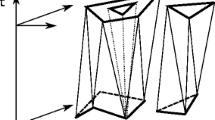Abstract
Many natural phenomena are intuitively represented as spatiotemporal data objects, or moving objects. For example, vehicles, rivers, hurricanes, low pressure systems, areas of high density of foliage, etc align well with a geometric representation, and all change position or shape over time. Moving object models exist that represent real world objects as point, line, and region geometries that change continuously over time, leading to research into spatiotemporal analysis functionality over these objects. Models of moving objects are ideal for representing data streams that record the motion of spatial data over time. However, the implementation of operations to support spatiotemporal analysis over moving objects, particularly over moving regions, has proven difficult. In this paper, we develop a mechanism to support the implementation of the set operations of intersection, union, and difference between pairs of moving regions. The mechanism builds on the Component Model of Moving Regions and the semantic specifications of its operations. Specifically, we develop a generalized method of computing an intermediate data structure from which the results of various operations are then derived. The mechanism utilizes well-known 2D and 3D operational primitives and achieves O(nlgn) time complexity using appropriate data structures.













Similar content being viewed by others
References
Berry JK (1987) Fundamental operations in computer-assisted map analysis. Int J Geogr Inf Syst 1(2):119–136
Cotelo Lema JA, Forlizzi L, Güting RH, Nardelli E, Schneider M (2003) Algorithms for moving objects databases. Comput J 46(6):680–712. doi:10.1093/comjnl/46.6.680. http://comjnl.oxfordjournals.org/content/46/6/680.abstract
Erwig M, Schneider M (1997) Partition and conquer. In: Spatial information theory a theoretical basis for GIS. Springer, pp 389–407
Erwig M, Schneider M (2000) Formalization of advanced map operations. In: 9th international symposium on spatial data handling, vol 8, pp 3–17
Forlizzi L, Güting RH, Nardelli E, Schneider M (2000) A data model and data structures for moving objects databases. SIGMOD Rec 29(2):319–330. doi:10.1145/335191.335426
Frank AU (1987) Overlay processing in spatial information system. University of Maine
Gottschalk S, Lin MC, Manocha D (1996) Obbtree: A hierarchical structure for rapid interference detection. In: Proceedings of the 23rd annual conference on computer graphics and interactive techniques, SIGGRAPH ’96. ACM, New York, pp 171–180. doi:10.1145/237170.237244
Güting RH, Böhlen MH, Erwig M, Jensen CS, Lorentzos NA, Schneider M, Vazirgiannis M (2000) A foundation for representing and querying moving objects. ACM Trans Database Syst 25(1):1–42. doi:10.1145/352958.352963
McKenney M Pyspatiotemporalgeom source code. https://bitbucket.org/marmcke/pyspatiotemporalgeom/ (2015). Accessed: 2014-08-21
McKenney M, Shelby R, Bagg S (2015) Component moving region operations: Implementing set operations on region streams. In: Proceedings of the 6th ACM SIGSPATIAL international workshop on geostreaming, IWGS ’15. ACM, New York
McKenney M, Viswanadham SC, Littman E (2014) The cmr model of moving regions. In: Proceedings of the 5th ACM SIGSPATIAL international workshop on geostreaming, IWGS ’14. ACM, New York, pp 62–71. doi:10.1145/2676552.2676564
McKenney M, Webb J (2010) Extracting moving regions from spatial data. In: Proceedings of the 18th SIGSPATIAL international conference on advances in geographic information systems, GIS ’10. ACM, New York, pp 438–441. doi:10.1145/1869790.1869856
Mckennney M, Frye R (2015) Generating moving regions from snapshots of complex regions. ACM Trans Spatial Algoritm Syst 1(1):4:1–4:30. doi:10.1145/2774220
Schneider M, Behr T (2006) Topological relationships between complex spatial objects. ACM Trans. Database Syst 31(1):39–81. doi:10.1145/1132863.1132865
Scholl M, Voisard A (1990) Thematic map modeling. In: Design and implementation of large spatial databases. Springer, pp 167–190
Sistla AP, Wolfson O, Chamberlain S, Dao S (1997) Modeling and querying moving objects. In: Proceedings of the 13th international conference on data engineering, ICDE ’97. IEEE Computer Society, Washington, pp 422–432. http://dl.acm.org/citation.cfm?id=645482.653301
Tossebro E, Guting R (2001) Creating representations for continuously moving regions from observations. In: Jensen C, Schneider M, Seeger B, Tsotras V (eds) Advances in spatial and temporal databases, lecture notes in computer science, vol 2121. Springer Berlin Heidelberg, pp 321–344
Worboys MF (1994) A unified model for spatial and temporal information. Comput J 37(1):26–34. doi:10.1093/comjnl/37.1.26. http://comjnl.oxfordjournals.org/content/37/1/26.abstract
Author information
Authors and Affiliations
Corresponding author
Rights and permissions
About this article
Cite this article
McKenney, M., Shelby, R. & Bagga, S. Implementing set operations over moving regions using the component moving region model. Geoinformatica 21, 323–350 (2017). https://doi.org/10.1007/s10707-016-0259-9
Received:
Accepted:
Published:
Issue Date:
DOI: https://doi.org/10.1007/s10707-016-0259-9




